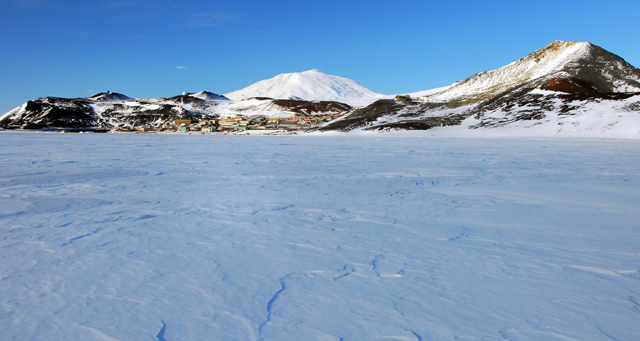Page 2/2 - Posted June 19, 2009
All about albedoThe runaway effect is thanks to the high albedo, or reflectivity, of snow and ice. The bright, white surface reflected the sunlight, and without much of a greenhouse to capture and store the heat in the atmosphere, the planet continued to cool and cool and cool. Temperatures probably reached about minus 30 degrees Celsius at the equator during Snowball Earth events, which may have lasted 10 to 30 million years. The big thaw was a probably little less complicated. Without humans around to drive SUVs and pilot airplanes, the planet had to rely on a natural source to re-charge Earth’s greenhouse — Kasting’s volcanoes. The snow- and ice-covered planet at its extreme had very little in the way of a carbon sink, so carbon dioxide from volcanoes pumped CO2 levels back up. “There’s no rain; no way to remove carbon dioxide,” Warren explained. “It builds up until you get so strong a greenhouse effect that you start melting the ice at the equator.” Here is the more familiar scenario of today, where the bare ocean, with a much lower albedo, absorbs more sunlight and heat, creating a positive feedback of warming — much like what has happened in the Arctic in recent years. “It would have been a very rapid decline once it got started,” Warren noted. [For more information about Snowball Earth and the possible scenarios for glaciation and de-glaciation, check out Hoffman’s Snowball Earth Web site 
Photo Credit: Robyn Waserman/Antarctic Photo Library
Warren's team will begin their expedition for Snowball Earth on the sea ice in McMurdo Sound.
One could be forgiven for thinking that ice and snow are pretty much the same when it comes to reflecting sunlight. However, Warren, whose expertise is the albedo effect, said one of the biggest uncertainties surrounding Snowball Earth concerns surface reflectivity. “The reason for that is that the Earth would not have been totally snow covered,” he said. “There actually would have been quite a variety of surfaces. “These ice types — if the snowball hypothesis is correct — used to exist on the tropical ocean. Now, they exist only in Antarctica. Some of them don’t even exist in Antarctica, so we grow them in the laboratory.” Warren will lead a small team to look more closely at different ice conditions over the next two field seasons, starting with sea ice in McMurdo Sound during the Antarctic spring months of August and September. Conditions then should be cold and windy enough to create salt crystals in brine pockets within the sea ice. “The ice gets brighter and reflects more sunlight,” said Warren, whose three-member team will collaborate with a New Zealand group that is now spending the winter in Antarctica working on the sea ice. Investigations of other ice types will lead the team to the Garwood Valley later this season and then into the Transantarctic Mountains for the 2010-11 summer. His co-principal investigators, Bonnie Light and Edwin Waddington, will conduct laboratory experiments and modeling exercises to further examine the hypothesis. The project, while illuminating the distant past, has implications for contemporary studies of climate here and on other planets, Warren said. “It’s intriguing for all kinds of reasons. It’s the most dramatic climate change to have happened in the history of the planet and yet it’s only been widely recognized in the last few years.” The Snowball Earth hypothesis, some have argued, may have even spurred biological evolution, something Hoffman and Schrag pointed out in a Scientific American article “That allows evolution to go on independently without competition from the other organisms developing in the other hotspots. It’s a way to promote evolution of diversity,” Warren said, adding that not long after the last snowball event, the Cambrian explosion, or radiation of complex animals, occurred. “That’s when we first see macroscopic fossils of animals,” he said. “If there had been no snowball event, then life might still be happily microscopic on the Earth.” NSF-funded research in this story: Stephen Warren, Edwin Waddington and Bonnie Light, University of Washington, Award No. 0739779 |



For USAP Participants |
For The Public |
For Researchers and EducatorsContact UsU.S. National Science FoundationOffice of Polar Programs Geosciences Directorate 2415 Eisenhower Avenue, Suite W7100 Alexandria, VA 22314 Sign up for the NSF Office of Polar Programs newsletter and events. Feedback Form |


